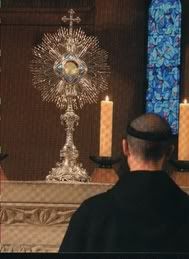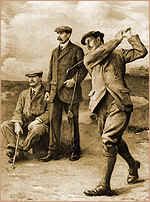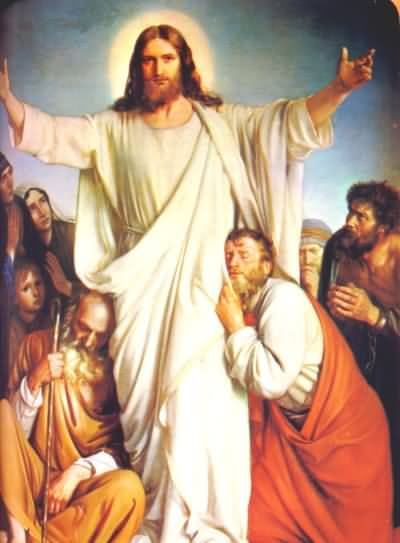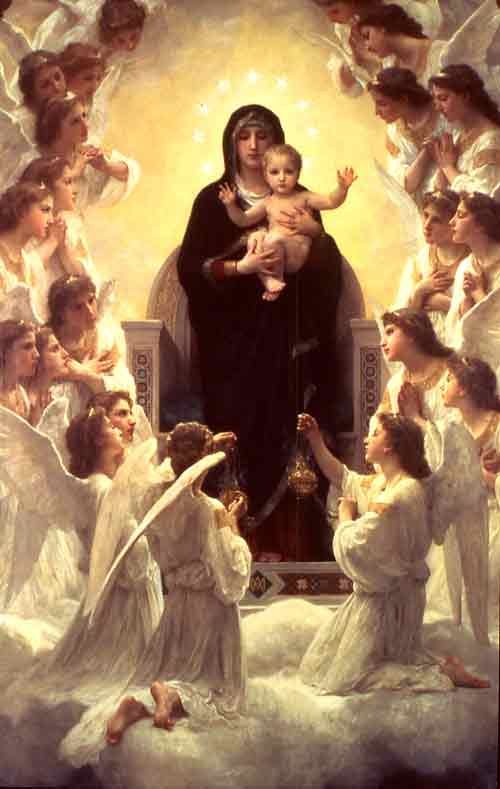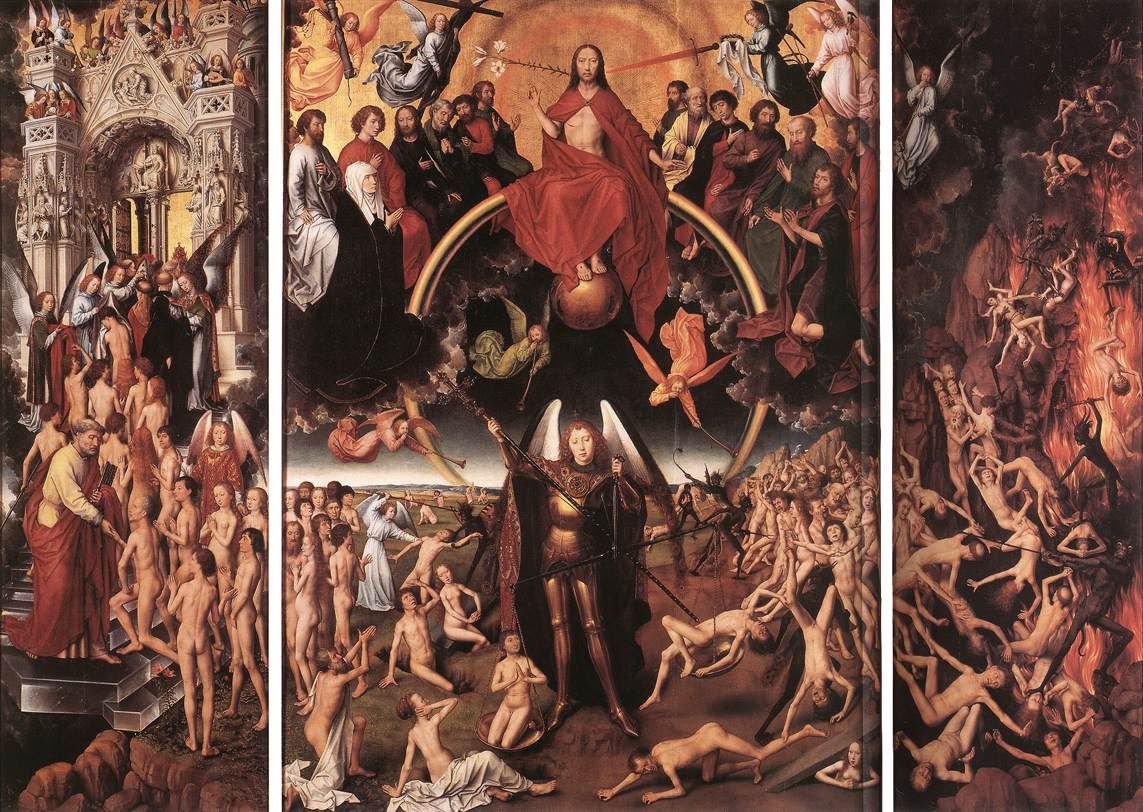Saturday, February 10, 2007
Into Great Silence
Will have its Boston-area opening at the "art-house" Kendall Square Theater in Cambridge on March 16th. I see some places are nt getting it until April and even May! So we should feel lucky that we are getting it so comparatively early.
Saint Scholastica
Friday, February 09, 2007
Requiescat In Pace
Such a waste. The modern celebrity culture sucks people into it with its promise of drugs and parties and money and notariety. So many, many people dream of getting their 15 minutes of fame, and making it last. Anna Nicole Smith was somebody who should have used her gift of beauty to marry a nice, hard-working millionaire near her own age, had a few children with him, and settled into a stable normative lifestyle as a wife and mother.
Instead, she opted for the big payoff. After her celebrity from a Playboy spread and Guess Jeans spokesmodel stint petered out, she married an 80-year-old billionaire, and ended up in endless litigation with his adult children. She lived the partying lifestyle complete with drugs, booze, illicit affairs, and heedless behaviour. I had just read a couple of days ago that she had a miscarriage in the recent past, in which alcohol and a trampoline figured prominently. Eventually, she became a sad caricature of herself and Marilyn Monroe (who she laboriously tried to emulate), complete with a dubious reality TV show, and paternity suits over who fathered her bastard child. Less than half a year ago, her first child died at age 19 from a drug overdose.
Yesterday, she was found dead in her hotel room, at age 39. Her mother is quoted as saying drugs were the most likely cause.
Requiescat in pace. Amen.
Instead, she opted for the big payoff. After her celebrity from a Playboy spread and Guess Jeans spokesmodel stint petered out, she married an 80-year-old billionaire, and ended up in endless litigation with his adult children. She lived the partying lifestyle complete with drugs, booze, illicit affairs, and heedless behaviour. I had just read a couple of days ago that she had a miscarriage in the recent past, in which alcohol and a trampoline figured prominently. Eventually, she became a sad caricature of herself and Marilyn Monroe (who she laboriously tried to emulate), complete with a dubious reality TV show, and paternity suits over who fathered her bastard child. Less than half a year ago, her first child died at age 19 from a drug overdose.
Yesterday, she was found dead in her hotel room, at age 39. Her mother is quoted as saying drugs were the most likely cause.
Requiescat in pace. Amen.
Thursday, February 08, 2007
New Banner Image
For the remainder of Septuagesima, mindful of the Church's call for a withdrawal into oneself to prepare for the great Fast of Lent, I have put up an image of the great Irish monastic site, Skellig Michael.
To Boston Area Traditional Catholics
You might want to think about patronizing the Fatima Center book shop on Thatcher Street in the North End. They have an excellent selection of books from TAN. The CMRI nuns staff the store. They are, of course, very traditional (in fact, considerably to my right, since they are sedevacantists). Why I bring this up now is that, with their one-year anniversary at the 27 Thatcher Street location coming up, I was told yesterday that they are reconsidering keeping it open. The location is terrible, about as out of the way as you can get. And they have not exactly been flooded with customers.
Now, of course, there is something to be said for not patronizing sedevacantists. They are in schism, since they don't recognize the legitimacy of the Holy Father and the most recent ecumenical council. But as far as I can see, the Catholic doctrine they hold is not heretical when it comes to faith and morals. In fact, it is quite solid.
I try to follow a "no-enemies-on-the-right" policy. The enemy is on the left. So I am willing to overlook the failings of potential allies. I don't care whether a Catholic is ultra-rad-trad, trad, sede, or neo. If they recognize that the Church has suffered a great disaster in the last 40 years, understand that the way Vatican II was implemented is to blame, and if they know that the solution to that problem is a return to Catholic tradition, then I welcome them as allies in so far as our interests coincide.
Besides which, if you are looking for genuine traditional Catholic books in Boston, you don't have many choices. The Fatima Center Book Store is a good resource, and traditional Catholics can patronize it for rosaries, medals, prints, crucifixes, and TAN titles in good conscience. Just don't buy any polemics on the state of the papacy. And it is convenient. You just get off the Orange or Green Line at Haymarket, and walk a couple of blocks into the North End (it is 2 short blocks down Thatcher Street from the original Pizzeria Regina), and there you are.
Where else can you go now? The Society For the Propagation of the Faith shop on Franklin? Severely lacking in almost every respect. There is another shop nearer the Common run by nuns, but it centers on liturgical goods (lots of vestments, tabernacles, etc). And it tends to be very modish. Hardly any books. Daughters of Saint Paul is practically in Dedham, and quite a hike on public transit. Carmelite Gift Shop at Peabody's North Shore Shopping Center? Well, they do have some, but not all, TAN titles. But it would take me, or anyone else coming from Boston on public transit, a half day just to get there. Andrew Lane? Even worse.
Now, of course, there is something to be said for not patronizing sedevacantists. They are in schism, since they don't recognize the legitimacy of the Holy Father and the most recent ecumenical council. But as far as I can see, the Catholic doctrine they hold is not heretical when it comes to faith and morals. In fact, it is quite solid.
I try to follow a "no-enemies-on-the-right" policy. The enemy is on the left. So I am willing to overlook the failings of potential allies. I don't care whether a Catholic is ultra-rad-trad, trad, sede, or neo. If they recognize that the Church has suffered a great disaster in the last 40 years, understand that the way Vatican II was implemented is to blame, and if they know that the solution to that problem is a return to Catholic tradition, then I welcome them as allies in so far as our interests coincide.
Besides which, if you are looking for genuine traditional Catholic books in Boston, you don't have many choices. The Fatima Center Book Store is a good resource, and traditional Catholics can patronize it for rosaries, medals, prints, crucifixes, and TAN titles in good conscience. Just don't buy any polemics on the state of the papacy. And it is convenient. You just get off the Orange or Green Line at Haymarket, and walk a couple of blocks into the North End (it is 2 short blocks down Thatcher Street from the original Pizzeria Regina), and there you are.
Where else can you go now? The Society For the Propagation of the Faith shop on Franklin? Severely lacking in almost every respect. There is another shop nearer the Common run by nuns, but it centers on liturgical goods (lots of vestments, tabernacles, etc). And it tends to be very modish. Hardly any books. Daughters of Saint Paul is practically in Dedham, and quite a hike on public transit. Carmelite Gift Shop at Peabody's North Shore Shopping Center? Well, they do have some, but not all, TAN titles. But it would take me, or anyone else coming from Boston on public transit, a half day just to get there. Andrew Lane? Even worse.
Wednesday, February 07, 2007
Today's Catholic Cultural Heritage Images
Today, we feature the Slipper Chapel near the Shrine of Our Lady of Walsingham. Of course, I don't need to tell you that the Shrine was once the principal Marian shrine in Catholic England. But then the Henrician/Edwardian/Elizabethan/Cromwellian liturgical reformers of the day got their blood-soaked hands on it. The shrine itself has been usurped by the Anglicans. But the Slipper Chapel, at the point, one mile away, where pilgrims would remove their shoes to walk the last mile of the pilgrimage barefoot, is in Roman Catholic hands.





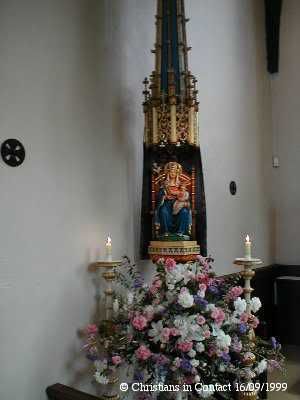


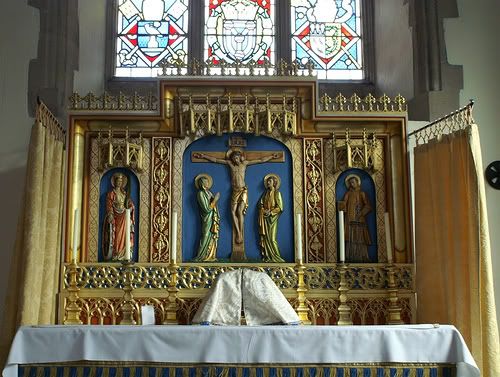









Yesterday Was World Nutella Day
Slip-Slidin' Away
The Celtics have now lost 15 games in a row.
So much for the latest effort to rebuild the franchise that gave us Cousy, Russell, Havlicheck, Cowens, Bird, Parrish, McHale, Johnson, and Ainge. Another year for the locusts to eat.
So much for the latest effort to rebuild the franchise that gave us Cousy, Russell, Havlicheck, Cowens, Bird, Parrish, McHale, Johnson, and Ainge. Another year for the locusts to eat.
A Thought
Occasionally, I do have one. Or something close to one, anyway.
I was thinking about the variation in Saints' Days between the traditional Ordo, and the Novus Ordo. When the calendar was reconfigured after Vatican II, there was quite a bit of minor tweaking to make sure a saint's feast fell on his or her date of death, if known. Some major saints saw their feasts shift a few days. St. Dominic, Saint Jean Vianney, Saint Alphonsus Liguori, and Saint Therese of Lisieux all saw their feasts moved a little.
And there were some major shifts. Saint Thomas the Apostle (one of my particular patrons, along with Saint George and Saint John the Evangelist, as well as Saint Patrick) was moved from December, and lost his status as an "Advent Saint" to be shunted to July.
And of course, dear Saint Christopher was dropped from the ordo altogether, as "mythical." However, in his case, there is a strong cultus following, since he is the patron of travellers. And to this day, even in Catholic gift shops heavily devoted to the new ways, you can buy a Saint Christopher medal, or statue. There was talk about dumping St. George, too. But his cult is also popular, and he is the patron of England, and of the patrons of soldiers.
But it occurred to me that the variation in Saints' Days between the old and new calendar is hardly a healthy thing. Those using the 1962 Missal seem frozen in time. And that strikes me as unhealthy. We never want the traditional Mass to become an object sealed in amber. Yet, saints (even saints of undoubted holiness, like St. Padre Pio) who were canonized after 1962 don't make the calendar.
One of the best things the Holy Father could do, whenever he gets around to liberalizing permission for the Latin Mass, is to do something to re-unify the ordos of the two modes of the Latin Rite. And a new standard Missal for the traditional Latin Mass needs to get Vatican sanction, one that updates the calendar for new saints, at the very least.
And this should not be all a one-way street. There should be negotiations with genuine give-and-take between any new Vatican dicastery (or prelature) handling the Latin Mass and the authorities in the Vatican overseeing the calendar of the Novus Ordo to re-unify the Church with regard to saints' days.
Traditionalists can probably live with shifting Ligouri, Vianney, etc. by a day or so, if it is for a good reason. And the modernists should accept the reversal of some of the changes they have made. Like St. Thomas. Really! No one knows when good St. Thomas really died. Why not just move his feast day back to December, where it has been since time out of mind. And what harm is there in putting St. Christopher back in the ordo?
But the main point is that the traditional Mass cannot be allowed to become a museum piece, frozen in 1962. I hope the Holy Father sees the wisdom of promulgating a new, updated version of the traditional Latin Mass' Missal, similiar to that published by Baronius under the imprimatur of the excellent Bishop Bruskewitz. Leave the translations just as they are in that Missal. Just add some new saints' days, so that traditionalists have a Mass for St. Pio, and can incorporate the Divine Mercy devotion into their Missals' appendices.
I was thinking about the variation in Saints' Days between the traditional Ordo, and the Novus Ordo. When the calendar was reconfigured after Vatican II, there was quite a bit of minor tweaking to make sure a saint's feast fell on his or her date of death, if known. Some major saints saw their feasts shift a few days. St. Dominic, Saint Jean Vianney, Saint Alphonsus Liguori, and Saint Therese of Lisieux all saw their feasts moved a little.
And there were some major shifts. Saint Thomas the Apostle (one of my particular patrons, along with Saint George and Saint John the Evangelist, as well as Saint Patrick) was moved from December, and lost his status as an "Advent Saint" to be shunted to July.
And of course, dear Saint Christopher was dropped from the ordo altogether, as "mythical." However, in his case, there is a strong cultus following, since he is the patron of travellers. And to this day, even in Catholic gift shops heavily devoted to the new ways, you can buy a Saint Christopher medal, or statue. There was talk about dumping St. George, too. But his cult is also popular, and he is the patron of England, and of the patrons of soldiers.
But it occurred to me that the variation in Saints' Days between the old and new calendar is hardly a healthy thing. Those using the 1962 Missal seem frozen in time. And that strikes me as unhealthy. We never want the traditional Mass to become an object sealed in amber. Yet, saints (even saints of undoubted holiness, like St. Padre Pio) who were canonized after 1962 don't make the calendar.
One of the best things the Holy Father could do, whenever he gets around to liberalizing permission for the Latin Mass, is to do something to re-unify the ordos of the two modes of the Latin Rite. And a new standard Missal for the traditional Latin Mass needs to get Vatican sanction, one that updates the calendar for new saints, at the very least.
And this should not be all a one-way street. There should be negotiations with genuine give-and-take between any new Vatican dicastery (or prelature) handling the Latin Mass and the authorities in the Vatican overseeing the calendar of the Novus Ordo to re-unify the Church with regard to saints' days.
Traditionalists can probably live with shifting Ligouri, Vianney, etc. by a day or so, if it is for a good reason. And the modernists should accept the reversal of some of the changes they have made. Like St. Thomas. Really! No one knows when good St. Thomas really died. Why not just move his feast day back to December, where it has been since time out of mind. And what harm is there in putting St. Christopher back in the ordo?
But the main point is that the traditional Mass cannot be allowed to become a museum piece, frozen in 1962. I hope the Holy Father sees the wisdom of promulgating a new, updated version of the traditional Latin Mass' Missal, similiar to that published by Baronius under the imprimatur of the excellent Bishop Bruskewitz. Leave the translations just as they are in that Missal. Just add some new saints' days, so that traditionalists have a Mass for St. Pio, and can incorporate the Divine Mercy devotion into their Missals' appendices.
Tuesday, February 06, 2007
Looking Ahead To Lent
The coming of the Season of Septuagesima brings to the forefront preparation for Lent. While the world is partying during Carnival, the faithful ought to be considering how they might best prepare for the great feast of Easter. This involves thinking about what things of this world you want to give up, and what virtues you want to begin practicing more comprehensively. It involves how you want to change your prayer life during Lent, and what you want to read in preparation, and what you want to view.
With this in mind, I would like to offer some suggestions for Lenten reading. All the titles I suggest are available through TAN Books.
The Agony of Jesus
by St. Padre Pio
Saints and Sinners of Calvary
By: Fr. Christopher Rengers O.F.M. Cap.
The School of Jesus Crucified
The Lessons of Calvary in Daily Catholic Life
By: Fr. Ignatius of the Side of Jesus Passionist
Sermons of St. Francis de Sales For Lent
By: St. Francis de Sales
The Seven Last Words Of Christ On the Cross
By: Fr. Christopher Rengers O.F.M. Cap.
The Shroud of Turin
A Case for Authenticity
By: Fr. Vittorio Guerrera
The Foot Of The Cross
By: Rev. Frederick William Faber
Devotion to the Sorrowful Mother
By: Anonymous
The Dolorous Passion Of Our Lord Jesus Christ
By: Blessed Anna Catherine Emmerich
With this in mind, I would like to offer some suggestions for Lenten reading. All the titles I suggest are available through TAN Books.
The Agony of Jesus
by St. Padre Pio
Saints and Sinners of Calvary
By: Fr. Christopher Rengers O.F.M. Cap.
The School of Jesus Crucified
The Lessons of Calvary in Daily Catholic Life
By: Fr. Ignatius of the Side of Jesus Passionist
Sermons of St. Francis de Sales For Lent
By: St. Francis de Sales
The Seven Last Words Of Christ On the Cross
By: Fr. Christopher Rengers O.F.M. Cap.
The Shroud of Turin
A Case for Authenticity
By: Fr. Vittorio Guerrera
The Foot Of The Cross
By: Rev. Frederick William Faber
Devotion to the Sorrowful Mother
By: Anonymous
The Dolorous Passion Of Our Lord Jesus Christ
By: Blessed Anna Catherine Emmerich
Sunday, February 04, 2007
Septuagesima Sunday
The Mystery of Septuagesima
from Abbott Prosper Gueranger, The Liturgical Year
The season upon which we are now entering is expressive of several profound mysteries. But these mysteries belong not only to the three weeks which are prearatory to Lent: they continue throughout the whole period of time which separates us from the great feast of Easter.
The number seven is the basis of all these mysteries. We have already seen how the holy Church came to introduce the season of Septuagesima into her calendar. Let us now meditate on the doctrine hidden under the symbols of her liturgy. And first, let us listen to St. Augustine, who thus gives is the clue to the whole of our season's mysteries. 'There are two times,' says the holy Doctor: 'one which is now, and is spent in the temptations and tribulations of this life; the other which shall by then, and shall be spent in eternal security and joy. In figure of these, we celebrate two periods: the time before Easter, and the time after Easter. That which is before Easter signifies the sorrow of this present life; that which is after Easter, the blessedness of our future state... Hence it is that we spend the first in fasting and prayer; and in the second we give up our fasting, and give ourselves to praise.'
The Church, the intepreter of the sacred Scriptures, often speaks to us of two places, which correspond with these two times of St. Augustine. These two places are Babylon and Jerusalem. Babylon is the image of this world of sin, in the midst whereof the Christian has to spend his years of probation; Jerusalem is the heavenly country, where he is to repose after all his trials. The people of Israel, whose whole history is but one great type of the human race, was banished from Jerusalem and kept in bondage in Babylon.
Now, this captivity, which kept the Israelites exiles from Sion, lasted seventy years; and it is to express this mystery, as Alcuin, Amalarius, Ivo of Chartres, and all the great liturgists tell us, that the Church fixed the number of seventy for the days of expiation. It is true, there are but sixty-three days between Septuagesima and Easter; but the Church, according to the style so continually used in the sacred Scriptures, uses the round number instead of the literal and precise one.
The duration of the world itself, according to the ancient Christian tradition, is divided into seven ages. The human race must pass through the seven ages before the dawning of the day of eternal life. The first age included the time from the creation of Adam to Noah; the second begins with Noah and the renovation of the earth by the deluge, and ends with this the vocation of Abraham; the third opens with this first formation of God's chosen people, and continues as far as Moses, through whom God gave the Law; the fourth consists of the period between Moses and David, in whom the house of Juda received the kingly power; the fifth is formed of the years which passed between David's reign and the captivity of Babylon, inclusively; the sixth dates from the return of the Jews to Jerusalem, and takes us on as far as the birth of our Saviour. Then, finally, comes the seventh age; it starts with the rising of this merciful Redeemer, the Sun of justice, and is to continue till the dread coming of the Judge of the livng and the dead. These are the seven great divisions of time; after which, eternity.
In order to console us in the midst of the combats, which so thickly beset our path, the Church, like a beacon shining amidst the darkness of this our earthly abode, shows us another seven, which is to succeed the one we are now preparing to pass through. After the Septuagesima of mourning, we shall have the bright Easter with its seven weeks of gladness, foreshadowing the happiness and bliss of heaven. After having fasted with our Jesus, and suffered with Him, the day will come when we shall rise together with Him, and our hearts shall follow Him to the hightest heavesn; and then after a brief interval, we shall feel the Holy Ghost descending upon us, with His seven Gifts. The celebration of all these wondrous joys will take us seven weeks, as the great liturgists observe in their interpretation of the rites of the Church. The seven joyous weeks from Easter to Pentecost will not be too long for the future glad mysteries, which, after all, will be but figures of a still gladder future, the future of eternity.
Having heard these sweet whisperings of hope, let us now bravely face the realities brought before us by our dear mother the Church. We are sojourners upon this earth; we are exiles and captives in Babylon, that city which plots our ruin. If we love our country, if we long to return to it, we must be proof against the lying allurements of this strange land, and refuse the cup she proffers us, and with which she maddens so many of our fellow captives. She invites us to join in her feasts and her songs; but we must unstring our harps, and hang them on the willows that grow on her river's bank, till the signal be given for our return to Jerusalem. She will ask us to sing to her the melodies of our dear Sion: but how shall we, who are so far from home, have heart to 'sing the song of the Lord in a strange land'? No, there must be no sign that we are content to be in bondage, or we shall deserve to be slaves forever.
These are the sentiments wherewith the Church would inspire us during the penitential season which we are now beginning. She wishes us to reflect on the dangers that beset us; dangers which arise from ourselves and from creatures. During the rest of the year she loves to hear us chant the song of heavne, the sweet Alleluia; but now, she bids us close our lips to this word of joy, because we are in Babylon. We are pilgrims absent from our Lord, let us keep our glad hymn for the day of His return. We are sinners, and have but too often held fellowship with the world of God's enemies; let us become purified by repentance, for it is written that 'praise is unseemly in the mouth of a sinner.'
The leading feature, then, of Septuagesima, is the total suspension of the Alleluia, which is not to again be heard upon the earth until the arrival of that happy day, when having suffered death with our Jesus, and having been buried together with Him, we shall rise again with Him to a new life.
The sweet hymn of the angels, Gloria in excelsis Deo, which we have sung every Sunday since the birth of our Saviour in Bethlehem, is also taken from us; it is only on the feasts of the saints which may by kept during the week that we shall be allowed to repeat it. The night Office of the Sunday is to lose also, from now till Easter, its magnificent Ambrosian hymn, the Te Deum; and at the end of the holy Sacrifice, the deacon will no longer dismiss the faithful with his solemn Ite, Missa est, but will simply invite them to continue their prayers in silence, and bless the Lord, the God of mercy, who bears with us, notwithstanding all our sins.
After the Gradual of the Mass, instead of the thrice repeated Alleluia, which prepared our hearts to listen to the voice of God in the holy Gospel, we hsall hear but a mournful and protracted chant, called, on that account, the Tract.
That the eye, too, may teach us that the season we are entering on is one of mourning, the Church will vest her ministers (both on Sundays and on the days during the week which are not feasts of Saints) in the sombre purple. Until Ash Wednesday, however, she permits the deacon to wear his dalmatic, and the subdeacon his tunic; but from that day forward, they must lay aside these vestments of joy, for Lent will then have begun and our holy mother will inspire us with the deep spirit of penance, but suppressing everything of that glad pomp, which she loves at other seasons, to bring into the sanctuary of her God.
from Abbott Prosper Gueranger, The Liturgical Year
The season upon which we are now entering is expressive of several profound mysteries. But these mysteries belong not only to the three weeks which are prearatory to Lent: they continue throughout the whole period of time which separates us from the great feast of Easter.
The number seven is the basis of all these mysteries. We have already seen how the holy Church came to introduce the season of Septuagesima into her calendar. Let us now meditate on the doctrine hidden under the symbols of her liturgy. And first, let us listen to St. Augustine, who thus gives is the clue to the whole of our season's mysteries. 'There are two times,' says the holy Doctor: 'one which is now, and is spent in the temptations and tribulations of this life; the other which shall by then, and shall be spent in eternal security and joy. In figure of these, we celebrate two periods: the time before Easter, and the time after Easter. That which is before Easter signifies the sorrow of this present life; that which is after Easter, the blessedness of our future state... Hence it is that we spend the first in fasting and prayer; and in the second we give up our fasting, and give ourselves to praise.'
The Church, the intepreter of the sacred Scriptures, often speaks to us of two places, which correspond with these two times of St. Augustine. These two places are Babylon and Jerusalem. Babylon is the image of this world of sin, in the midst whereof the Christian has to spend his years of probation; Jerusalem is the heavenly country, where he is to repose after all his trials. The people of Israel, whose whole history is but one great type of the human race, was banished from Jerusalem and kept in bondage in Babylon.
Now, this captivity, which kept the Israelites exiles from Sion, lasted seventy years; and it is to express this mystery, as Alcuin, Amalarius, Ivo of Chartres, and all the great liturgists tell us, that the Church fixed the number of seventy for the days of expiation. It is true, there are but sixty-three days between Septuagesima and Easter; but the Church, according to the style so continually used in the sacred Scriptures, uses the round number instead of the literal and precise one.
The duration of the world itself, according to the ancient Christian tradition, is divided into seven ages. The human race must pass through the seven ages before the dawning of the day of eternal life. The first age included the time from the creation of Adam to Noah; the second begins with Noah and the renovation of the earth by the deluge, and ends with this the vocation of Abraham; the third opens with this first formation of God's chosen people, and continues as far as Moses, through whom God gave the Law; the fourth consists of the period between Moses and David, in whom the house of Juda received the kingly power; the fifth is formed of the years which passed between David's reign and the captivity of Babylon, inclusively; the sixth dates from the return of the Jews to Jerusalem, and takes us on as far as the birth of our Saviour. Then, finally, comes the seventh age; it starts with the rising of this merciful Redeemer, the Sun of justice, and is to continue till the dread coming of the Judge of the livng and the dead. These are the seven great divisions of time; after which, eternity.
In order to console us in the midst of the combats, which so thickly beset our path, the Church, like a beacon shining amidst the darkness of this our earthly abode, shows us another seven, which is to succeed the one we are now preparing to pass through. After the Septuagesima of mourning, we shall have the bright Easter with its seven weeks of gladness, foreshadowing the happiness and bliss of heaven. After having fasted with our Jesus, and suffered with Him, the day will come when we shall rise together with Him, and our hearts shall follow Him to the hightest heavesn; and then after a brief interval, we shall feel the Holy Ghost descending upon us, with His seven Gifts. The celebration of all these wondrous joys will take us seven weeks, as the great liturgists observe in their interpretation of the rites of the Church. The seven joyous weeks from Easter to Pentecost will not be too long for the future glad mysteries, which, after all, will be but figures of a still gladder future, the future of eternity.
Having heard these sweet whisperings of hope, let us now bravely face the realities brought before us by our dear mother the Church. We are sojourners upon this earth; we are exiles and captives in Babylon, that city which plots our ruin. If we love our country, if we long to return to it, we must be proof against the lying allurements of this strange land, and refuse the cup she proffers us, and with which she maddens so many of our fellow captives. She invites us to join in her feasts and her songs; but we must unstring our harps, and hang them on the willows that grow on her river's bank, till the signal be given for our return to Jerusalem. She will ask us to sing to her the melodies of our dear Sion: but how shall we, who are so far from home, have heart to 'sing the song of the Lord in a strange land'? No, there must be no sign that we are content to be in bondage, or we shall deserve to be slaves forever.
These are the sentiments wherewith the Church would inspire us during the penitential season which we are now beginning. She wishes us to reflect on the dangers that beset us; dangers which arise from ourselves and from creatures. During the rest of the year she loves to hear us chant the song of heavne, the sweet Alleluia; but now, she bids us close our lips to this word of joy, because we are in Babylon. We are pilgrims absent from our Lord, let us keep our glad hymn for the day of His return. We are sinners, and have but too often held fellowship with the world of God's enemies; let us become purified by repentance, for it is written that 'praise is unseemly in the mouth of a sinner.'
The leading feature, then, of Septuagesima, is the total suspension of the Alleluia, which is not to again be heard upon the earth until the arrival of that happy day, when having suffered death with our Jesus, and having been buried together with Him, we shall rise again with Him to a new life.
The sweet hymn of the angels, Gloria in excelsis Deo, which we have sung every Sunday since the birth of our Saviour in Bethlehem, is also taken from us; it is only on the feasts of the saints which may by kept during the week that we shall be allowed to repeat it. The night Office of the Sunday is to lose also, from now till Easter, its magnificent Ambrosian hymn, the Te Deum; and at the end of the holy Sacrifice, the deacon will no longer dismiss the faithful with his solemn Ite, Missa est, but will simply invite them to continue their prayers in silence, and bless the Lord, the God of mercy, who bears with us, notwithstanding all our sins.
After the Gradual of the Mass, instead of the thrice repeated Alleluia, which prepared our hearts to listen to the voice of God in the holy Gospel, we hsall hear but a mournful and protracted chant, called, on that account, the Tract.
That the eye, too, may teach us that the season we are entering on is one of mourning, the Church will vest her ministers (both on Sundays and on the days during the week which are not feasts of Saints) in the sombre purple. Until Ash Wednesday, however, she permits the deacon to wear his dalmatic, and the subdeacon his tunic; but from that day forward, they must lay aside these vestments of joy, for Lent will then have begun and our holy mother will inspire us with the deep spirit of penance, but suppressing everything of that glad pomp, which she loves at other seasons, to bring into the sanctuary of her God.
























